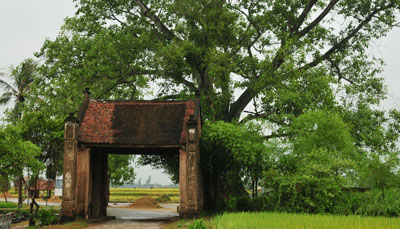5 Ancient Villages: Tourist Destination

- Duong Lam, Hanoi. Duong Lam Village is considered the oldest village in North Vietnam with 16th century houses that are very old but still beautiful. Located along the Red River, about 50 kilometers from Hanoi, there are 900 traditional houses that are aged but well-preserved. The roofs are tiled but covered with moss, the walls designed uniquely with laterite, and there are old wells and communal houses that have seen better days but are frequented by visitors because of its peaceful atmosphere. The village also has a system of ponds which creates a fresh and romantic scene to the whole place.
- Phuoc Tich, Thua Thien Hue. Considered a “living museum of Vietnamese rural culture,” Phuoc Tich is composed of “nha ruong,” hand-made traditional wooden houses which have 48 colums to represent the cult of the ancestors of Buddha. Each nha ruong is built with many beams called ruong and pillars called cot which are uniquely joined by mortise and tenon instead of nails. The pillars and beams are made of hard-to-find solid wood lim (iron wood), gu (sindora) or thong xanh (teranthera pine). The entire structure stands on big pillars on either a round or square stone base. The roof is made of brick tiles and there's a front garden as all nha ruong houses are. There are 100 nha ruong houses at Phuoc Tich, of which 12 are rare, between 150-200 years old and with one-of-a-kind carved columns and horizontal lacquered boards. Aside from the tourist favorite nha ruong, there are also 37 100-year old other houses, temples, ancent trees and old pottery items which visitors will surely appreciate. Phuoc Tich is located at the basin of O Lau River, at the boundary of Thua Thien – Hue and Quang Tri provinces, Central Vietnam, approximately 40 kilometers from Hue City.
- Long Tuyen, Can Tho. An architectural and cultural attraction in the Mekong Delta City with its natural scenery and century-old relics. It is home to six of the 18 national artifacts in Can Tho, located at Binh Thuy Temple and Nam Nha Pagoda (Binh Thuy Old House), whose origin is a mix of Western and Eastern influences, including Chinese, French, American, Cham and Japanese. This is also where the famous Ky Yen Festival is celebrated.
- Tuy Loan, Danang. A 500-year old village discovered by five families: Dang, Lam, Nguyen, Tran and Le. Proud of its several unique characteristics like ancient houses, breathtaking natural scenery, rich history and historical relics such as an old banyan tree, boat station, communal house, paper-making craft and My Quang (Quang rice noodles). The communal house is a particular pride of the village since it is listed as a historical and cultural relic by the Ministry of Culture and Information in 1999. It was built in 1889 and patterned after “Chong ruong – Gia thu” which means that the house has brick walls, pantile roof, jack tree wood pillars and flying dragon design. The whole structure covers an area of more than 110 meter square. Despite its extremely old age, the house is surprisingly well-preserved and still possess its natural beauty. The communal house is able to save 20 honors dating from Emperor Minh Mang's dynasty to Emperor Khai Dinh's reign. A two-day festival for peace and prosperity is held here every ninth to tenth day of the first lunar month of every year in which ceremonial activities like incense offering and flower floating are observed to remember national heroes and ancestors. Traditional constests and folk games are also played such as “bai choi” (singing while acting as playing cards), grilling “banh trang” (soft rice paper), cooking “banh chung” (square glutinous rice cakes), tug of war, climbing banana trees, catching eels and boat race. Tuy Luan Village is located at Hoa Phong Commune, Hoa Vang District, about 15 kilometers South West of Da Nang.
- Phong Nam, Da Nang. A traditional Vietnamese village with a 700-year old history. Used to be a part of Phong Le Village, a century-old community which was founded during the Cham period. Cham culture is known for its important relics which can be found at the Da Nang Museum of Cham Sculpture. Phong Le used to be divided into two parts: Phong Nam, which is currently under Hoa Vang District; and Phong Bac, now belonging to Cam Le District. The latter has since adapted to urbanization, but Phong Nam has purposefully and carefully preserved its atmosphere of tradition and simplicity. Pagodas, temples, communal houses, old houses, holy places and worship houses are some of the things one can discover at Phong Nam. The communal house of Emperor Yan-Shen Nong is one popular tourist destination in the area, famous because the said emperor invented farming and mythology in China. The famed Muc Dong festival which celebrates children who take care of buffaloes and prayer for good weather and good harvest is also held here every year on November 27-28. A procession and traditional games are just some of the activities practiced during this time which tourists find both interesting and enjoyable. Muc Dong Festival wasn't celebrated for a long time of 74 years but came back in 2010. Phong Nam Village is located at Hoa Chau Commune, Hoa Vang District or about 10 kilometers South West of Da Nang.









